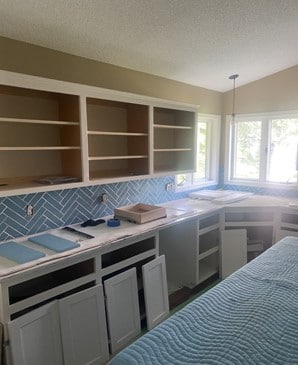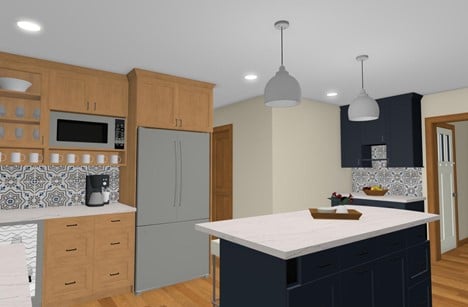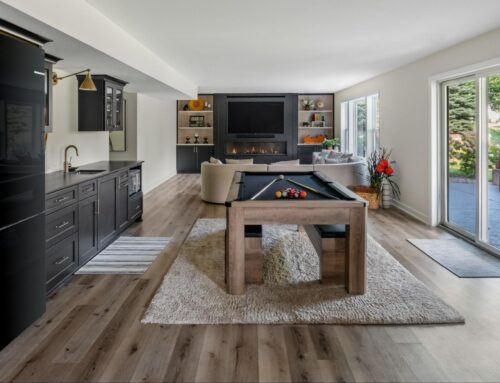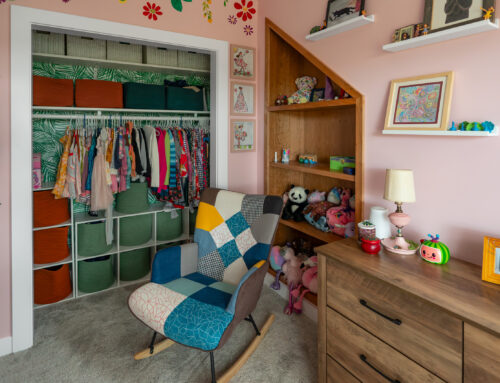From handmade tile and natural stone to budget-friendly subway tiles, our interior design team is sharing all the details to help you choose the right tile for your remodel.
Tile is a wonderful building material. In kitchens, bathrooms — even fireplace surrounds — it can set the tone and add a pop of personality to your space. But how do you choose the right tile for your remodel? Should you pick a patterned tile or stick with a classic? And what installation pattern should you choose? Selecting the right tile can easily feel overwhelming.
So today, our designers are sharing their top tips to help you choose the right tile for your bathroom, kitchen, or fireplace with confidence.
Common Types of Tile
Tile can be created from either man-made or nature-made materials. Let’s break down some of the common types of tile.
- Ceramic — Great for any room in the house, and equally at home on the floors and walls, ceramic tile is available in a variety of sizes, styles, textures, and finishes. It’s budget-friendly, durable, waterproof, and easy to clean, so you really can’t go wrong in any room in the house.
- Porcelain — With similar benefits, porcelain tiles are even more durable than their ceramic counterparts. This makes them a great choice for bathrooms and high-traffic areas, including showers and kitchen backsplashes. Porcelain is a great option for long-lasting tiles that can stand up to kids, pets, and the messes they bring.
- Glass — Glass tiles are making a comeback and can come in a range of styles and colors. From small iridescent mosaics to bright, bold squares and everything in between. They’re impervious to moisture, making them easy to keep clean, and their sheen can make small bathrooms feel bigger and brighter.
Designer’s note: Glass tiles can be tricky to install, so it’s best to hire a pro.
Can’t find your perfect color? Try painting the wall behind! Since glass tiles are semi-transparent, you can alter the final color with a coat of paint.
- Stone — Natural stone tiles, like slate, pebble mosaics, and marble are a wonderful way to introduce warmth and texture. They’re more porous than the other tile options, though, so they do require a bit more work and maintenance to keep them free from dirt and grime. A sealer can help keep them looking like new, especially in high-traffic areas.
Other types of tile gaining popularity this year include terrazzo, terracotta, and zellige, a hand-scraped ceramic tile with a slightly iridescent finish.
Glazed vs unglazed tiles — what’s the difference?
All man-made tiles are fired in a kiln, a special furnace for making pottery, brick, or tile. These kilns reach extreme temperatures — upwards of 2,000 degrees fahrenheit, depending on the material. During the process, a layer of liquid glass, or glaze, can be added. This allows for a range of colors and finishes and gives tiles their familiar sheen.
Not all tiles are glazed, though. Some prefer the natural hues and texture, so tiles are left unglazed.
Curious to know the pros and cons of glazed vs unglazed tiles?
Ideal for showers, tub surrounds, and kitchen backsplashes, glazed tiles:
- Offer a wider range of colors, finishes, and styles.
- Are non-porous, so they’re stain resistant and easy to clean
- This water-resistant finish can make them more slippery though, and tiles with a shiny surface are more prone to scratching than unglazed tiles
Ideal for flooring, commercial spaces, and high-traffic areas, unglazed tiles:
- More slip and scratch resistant
- Colors and textures pair beautifully with natural woods and rustic interiors (or are a great way to bring warmth to more modern spaces).
- Their lack of sheen does make them more vulnerable to stains and discoloration though, and unglazed tiles require more care and cleaning
Natural tiles vs unglazed tiles
Natural tiles (like stone, marble, and rock) are similar to unglazed tile in that they bring lovely texture and warmth to a space. Natural materials can also create a stunning focal point with strong veining or natural pattern, and their variations create texture, too.
While there’s no real right or wrong in the world of tile, it’s important to know the difference between glazed and unglazed tiles so you can select the right tile for your space and lifestyle.
Standard tile sizes and large-scale tile options
Even after you’ve selected your type of tile, there are limitless options for size and scale. From mosaics and penny tile to classic subway — all the way up to massive multi-foot slabs, there’s a lot to consider.
Standard-sized tiles (anything up to 12”x24”) are typically less expensive per square foot than larger tiles or slabs. Standard sizes are also easier to install. You can cut and trim them to fit around mouldings, cabinet corners, and plumbing.
Larger-scale tiles, on the other hand, are a bit trickier. Because of the way they’re made, larger tiles tend to have a slight arc in the surface. While this isn’t a quality issue, it means they can feel uneven underfoot if not professionally installed to ensure the edges are properly aligned.
Large-format tiles and slab-style installations are gaining popularity in the design world. We love the trend and are excited to reveal some upcoming projects featuring stone slabs, so stay tuned!
Designer’s note: Large format tiles should always be installed by a professional. They’re heavy and awkward, and might be difficult to cut without specialized tools. Plus, due to their size and price point, one wrong DIY move can thwart your budget.
Also, the size of the room doesn’t have to dictate the size of your tile. So don’t be afraid to get creative.
Tile installation: important things to consider
Selecting the right tile is only half the battle. Now you’ve got to decide how to install it.
Tile installation can turn the most basic, budget-friendly subway tile into a style statement. Think outside the box with unique patterns like:
- Herringbone
- Chevron
- Crosshatch/basketweave
- Stacked
- Or the classic running bond
This post from A Beautiful Mess illustrates the many options of laying out simple tiles.

Then, consider your grout color. You can match your grout color to the tile for a minimalist look. Or, opt for a higher contrast option to play up the pattern. Really want to make a statement? You can even get grout in bright, bold colors like red, blue, black, or even gold. You’ll need to seal your grout to prevent discoloration over time. Here at Titus, our standard grout has the sealer built right in!
Designer’s note: If you’re using natural stone or marble, installation is everything. Their natural variations in color and texture are what you love — but it takes some effort to avoid an accidental pattern or cluster of dark tiles. Make sure your installer pays close attention to the color and texture of each tile to ensure a perfectly-imperfect final look.
Want a little help choosing the right tile for your remodel?
No more aimless wandering the big box stores, craning your neck at the samples and trying to find the actual products.










